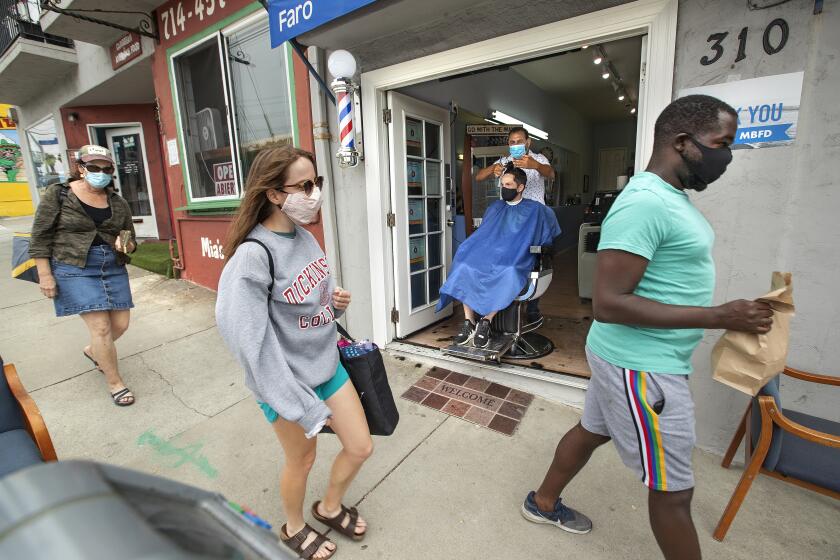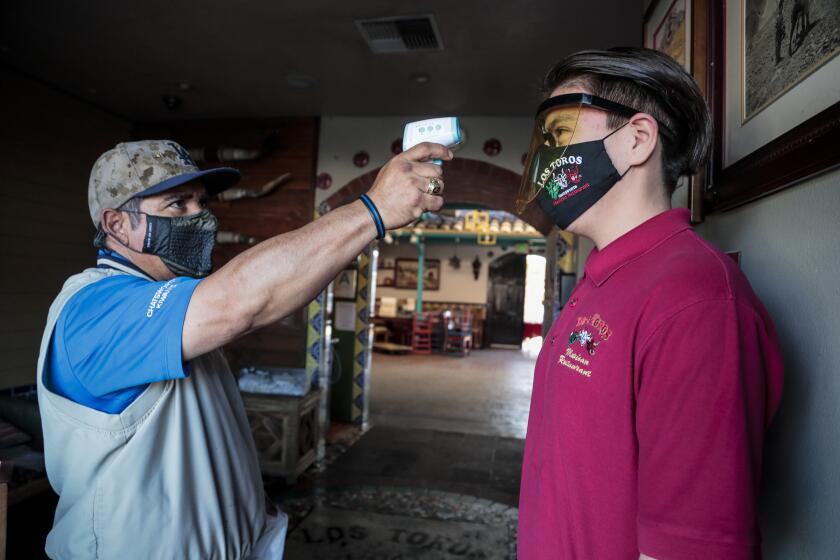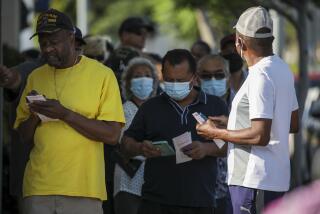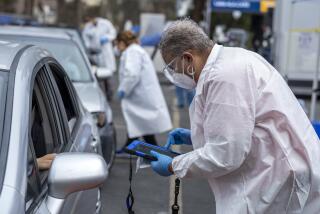San Francisco, Silicon Valley, other areas allowed to resume indoor dining, gym reopenings
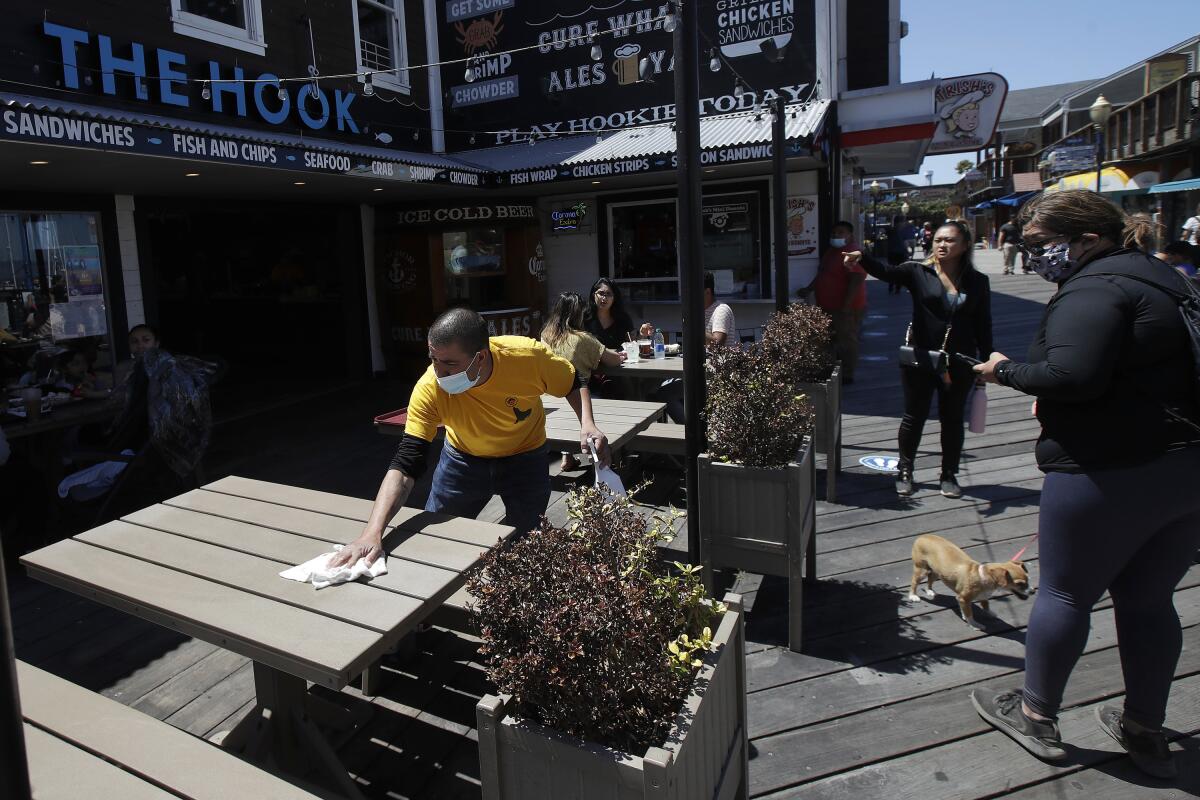
- Share via
More parts of California will be allowed to further reopen their economies this week amid both growing optimism, as the last coronavirus wave continues to recede, and swirling concern that new variants of the virus threaten to imperil progress.
According to the latest state data, seven counties will move from the purple tier — the strictest level in the state’s four-category reopening road map — into the more permissive red tier, effective Wednesday.
The advancement of Santa Clara, San Francisco, San Luis Obispo, El Dorado, Napa, Lassen and Modoc counties grows the number of counties that have progressed out of the purple tier to 18, and raises the number of Californians living outside areas with the highest restrictions from about 1.6 million to 5 million, or about 13% of the state’s population.
Counties are assigned to tiers based on three criteria: their average coronavirus case rates, which are adjusted based on the number of tests performed; testing positivity rate; and a health equity metric intended to ensure the positivity rate in poor communities of color does not significantly lag behind the overall county figure.
Del Norte, Humboldt, Trinity, Shasta, Plumas, Yolo, Marin, San Mateo and Mariposa counties were already in the red tier. Two counties — Sierra and Alpine — have gone a step further, into the orange tier.
No county is currently in the least stringent yellow category.
Counties must meet the next tier’s criteria for two weeks to advance. Based on state data released Tuesday, 12 counties could potentially move ahead next week, including nine currently in the purple tier: Alameda, Butte, Calaveras, Imperial, Mono, Placer, Santa Cruz, Solano and Tuolumne.
With the numbers of newly confirmed coronavirus infections and COVID-19 hospitalizations continuing to fall, Gov. Gavin Newsom said he expects counties to continue moving forward within the state’s reopening blueprint.
“I’m very encouraged by the stabilization — the case rates, the positivity rate,” he said Monday. “We do anticipate a majority of Californians in the next few weeks to be residing in counties that have moved out of the most restrictive purple tier.”
For counties within that category, many businesses and public facilities have to suspend or severely limit their indoor operations, as officials and experts say such settings can present a heightened risk of coronavirus transmission. Other types of businesses, like theme parks, concert venues and bars that don’t serve food, are closed entirely.
California’s average daily coronavirus case count is down almost 46% from two weeks ago, but experts warn now is not the time to lower your guard.
Those restrictions are gradually relaxed as counties move through the tier system. Counties in the red tier, for instance, can allow dining rooms and movie theaters to reopen with capacity at 25% or up to 100 people, whichever is fewer. Gyms and dance and yoga studios can open at 10% capacity. Museums, zoos and aquariums can open indoor activities at 25% capacity.
Stores, indoor malls and libraries can open at 50% capacity — though indoor malls must keep common areas closed and reduce capacity at food courts.
Those tier rules serve as a baseline for local health agencies, which can adopt even stricter rules if they feel it’s necessary, though they cannot be more lenient. Some areas, such as Los Angeles County and parts of the Bay Area, have periodically imposed restrictions beyond what the state requires.
San Francisco, however, will resume indoor dining Wednesday as the city moves out of the most restrictive coronavirus tier for reopening.
“We are in an amazing place,” a jubilant Mayor London Breed said at an outdoor news conference Tuesday. “We are not completely where we want to be, but better than we have been since October of last year.”
While much of the state, including L.A. County, will remain stuck in the purple tier for the immediate future, the progression of any counties comes as welcome news following the winter surge, which saw coronavirus infections, COVID-19 hospitalizations and related deaths skyrocket.
Over the last few weeks, the state’s coronavirus numbers have fallen to levels not seen in months. However, as has often been the case throughout the pandemic, that optimism carries with it a kernel of caution.
California and N.Y. mutant coronavirus variants are ‘worrisome’
Though the state is heading in the right direction, the rate of decline has slowed, sparking some concerns that the number of new cases could stall at an elevated rate, hampering a move toward wider reopenings.
Newsom acknowledged Monday that “we are seeing a little bit of a plateau, and one needs to be mindful of that.”
Officials at the federal level have expressed similar worries and said it’s still too early to abandon the public health protocols that fueled the recent turnaround.
Dr. Rochelle Walensky, director of the U.S. Centers for Disease Control and Prevention, said Monday that she remained “deeply concerned about a potential shift in the trajectory of the pandemic” and is “really worried about reports that more states are rolling back the exact public health measures we have recommended to protect people from COVID-19.”
That’s especially the case, she said during a briefing, given the continued proliferation of more-infectious coronavirus variants.
“At this level of cases, with variants spreading, we stand to completely lose the hard-earned ground we have gained,” Walensky said. “These variants are a very real threat to our people and our progress. Now is not the time to relax the critical safeguards that we know can stop the spread of COVID-19 in our communities, not when we are so close.”
California has reported an average of 5,224 new coronavirus cases per day over the last week, according to data compiled by The Times. That’s a nearly 35% decrease from two weeks ago.
Hospitalizations have also continued to fall. As of Sunday, 4,912 coronavirus-positive patients were hospitalized statewide, the lowest figure since Nov. 19. The number of Californians battling COVID-19 in intensive care units — 1,439 — has also fallen to pre-Thanksgiving levels.
Meanwhile, the pace of vaccinations has ramped up. Over the last week, providers throughout California have administered 235,711 doses per day, the highest rolling average to date.
Overall, almost 9.1 million doses have been administered statewide.
But with supplies remaining tight, officials say the best way to forge ahead is for residents and businesses to continue taking steps to protect themselves, their loved ones and their patrons. That means wearing masks in public, regular handwashing and maintaining physical distance from those you don’t live with.
“We now have a timeline on the end of this pandemic, but those days are not here yet,” L.A. County Supervisor Hilda Solis said this week. “So, please, don’t risk it right before vaccine may be available to you. I know it’s been tough, but we’ve collectively held on so far, so we need to just keep hanging in together.”
Times staff writer Maura Dolan contributed to this report.
More to Read
Sign up for Essential California
The most important California stories and recommendations in your inbox every morning.
You may occasionally receive promotional content from the Los Angeles Times.
